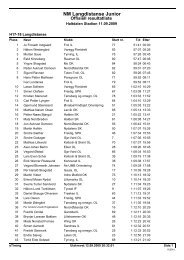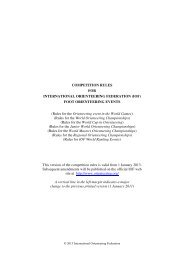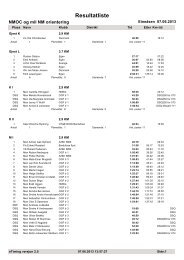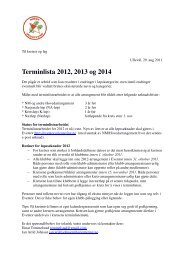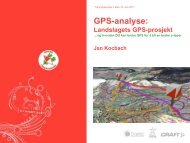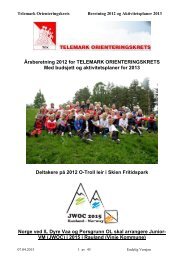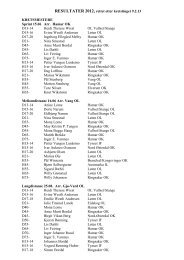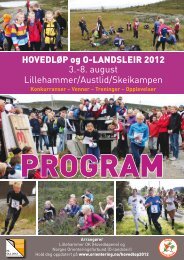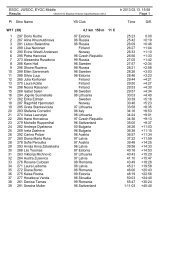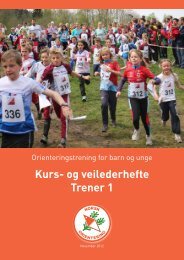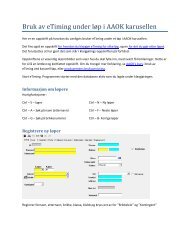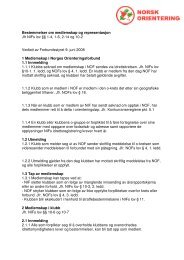International Specification for Orienteering Maps
International Specification for Orienteering Maps
International Specification for Orienteering Maps
You also want an ePaper? Increase the reach of your titles
YUMPU automatically turns print PDFs into web optimized ePapers that Google loves.
For smaller competitions, maps are likely to be reproduced in relatively small quantities and <strong>for</strong> this the new andcheaper printing methods are well suited.Please refer also to section 3.4 Printing, in this publication.6.6 Recommended symbols6.6.1 Use of foot-o symbolsThe following symbols from the foot-orienteering map specification are recommended <strong>for</strong> the mountain bikeorienteering map.Land <strong>for</strong>msThe shape of land is shown by means of contours. In order to maintain legibility of the map with scales down to1:30 000, when cycling at high speed the contour lines may be more generalised in comparison to foot-o maps.Form lines shall be omitted.101 Contour, 102 Index contour, 104 Slope line, 105 Contour value, 106 Earth bank, 109 Erosion gully, 111 Knoll,114 Depression.Rock and bouldersRocks and boulders are not likely to affect route choice, but where prominent they can serve as valuable features<strong>for</strong> navigation and positioning. The map may show these features when they are visible to the competitor.201 Impassable cliff, 202 Rock pillars/cliffs, 207 Large boulder, 208 Boulder field, 209 Boulder cluster, 211 Opensandy ground, 212 Bare rock.Water and marshBesides navigation and positioning, this group is important to the competitor as it facilitates the interpretation ofheight (what is "up" and what is "down") in maps with complex contouring.301 Lake, 304 Uncrossable river, 305 Crossable watercourse, 306 Crossable small watercourse, 307 Minorwater channel, 309 Uncrossable marsh, 310 Marsh, 314 Special water feature.Open land and vegetationThe representation of vegetation is of importance to the competitor only <strong>for</strong> navigational purposes, not <strong>for</strong> routechoices. If <strong>for</strong> example the <strong>for</strong>est is dense on one side of the path and sparse on the other, this presents navigationand positioning in<strong>for</strong>mation. It is not necessary to grade the <strong>for</strong>est <strong>for</strong> "speed" purposes unlike maps <strong>for</strong> footorienteering,only <strong>for</strong> visibility. In order to meet the demands <strong>for</strong> highest possible legibility, the 30% green colourused <strong>for</strong> 406 Forest slow running has been judged optimal.It should also be noted that the symbols 414 and 416 (cultivation boundaries) should be omitted since they maycause confusion with some of the symbols used <strong>for</strong> tracks and paths.401 Open land, 402 Open land with scattered trees, 403 Rough open land, 404 Rough open land with scatteredtrees, 405 Open <strong>for</strong>est, 406 Forest: slow running, 412 Orchard, 413 Vineyard, 415 Cultivated land, 418, 419,420Special vegetation features.Man-made featuresAs stated above, the track and path network provides in<strong>for</strong>mation fundamental to the competitor. Since a new setof symbols <strong>for</strong> detailed classification of this network is introduced, the corresponding symbols used in footorienteeringmaps are omitted.501 Motorway, 502 Major road, 503 Minor road, 515 Railway, 516 Power line, 517 Major power line, 518 Tunnel,521 High stone wall, 524 High fence, 525 Crossing point, 526 Building, 527 Settlement, 529 Paved area, 531Firing range, 534 Uncrossable pipeline, 536 High tower, 540,541 Special man-made features.6.6.2 Discipline-specific symbolsThe following symbols are introduced <strong>for</strong> mountain bike orienteering maps.Road and track classificationMountain bike orienteering requires two classifications <strong>for</strong> tracks and paths: a. speed (or "riding") and b. width.Three classes of speed and two classes of width, given in all six combinations, is optimal.Note: dimensions arespecified in mm atthe scale of 1:15 000.All drawings are at1:7 500 <strong>for</strong> clarity only.0.5 3.00.53.00.5 1.50.5 1.5"Riding" classificationThree levels of classification is proposed: EASY, SLOW, DIFFICULT.Width classificationTwo levels of width is proposed:MORE THAN 1.5 m WIDE (termed "TRACK")vehicle trackcan be used by four wheeled vehicles, cars, tractors, <strong>for</strong>estryalways possible to pass or cross other bikersLESS THAN 1.5 m WIDE (termed "PATH")too narrow <strong>for</strong> a four wheeled vehiclehiking path811 Track: easy ridingA track with stabilised surface at least 1.5 m wide. Forest road or well maintained0.6 track with no obstacles.Colour: black.812 Path: easy ridingWell maintained path narrower than 1.5 m. Smooth, clean path with no erosion or0.35obstacles.Colour: black.813 Track: slow ridingA track at least 1.5 m wide. Infrequently used, with ruts, grassy, wet, muddy or sandy.0.6Possibility of rocky surfaces. Pedalling is more difficult, riding is slowed.Colour: black.814 Path: slow riding0.35 Path narrower than 1.5 m, through difficult terrain, with rocky or banked surface.Other characteristics as in 813.Colour: black.815 Track: difficult to rideRarely used track at least 1.5 m wide, with obstacles such as roots or rocky steps.0.6 Many obstacles, stones, rocks, erosion, mud, lad slides or sand. Very slow orimpossible riding. Could necessitate to carry bike.Colour: black.816 Path: difficult to ride0.35 Path narrower than 1.5 m, through very difficult terrain. Mountain paths with manyobstacles. Other characteristics as in 815.Colour: black.2728




